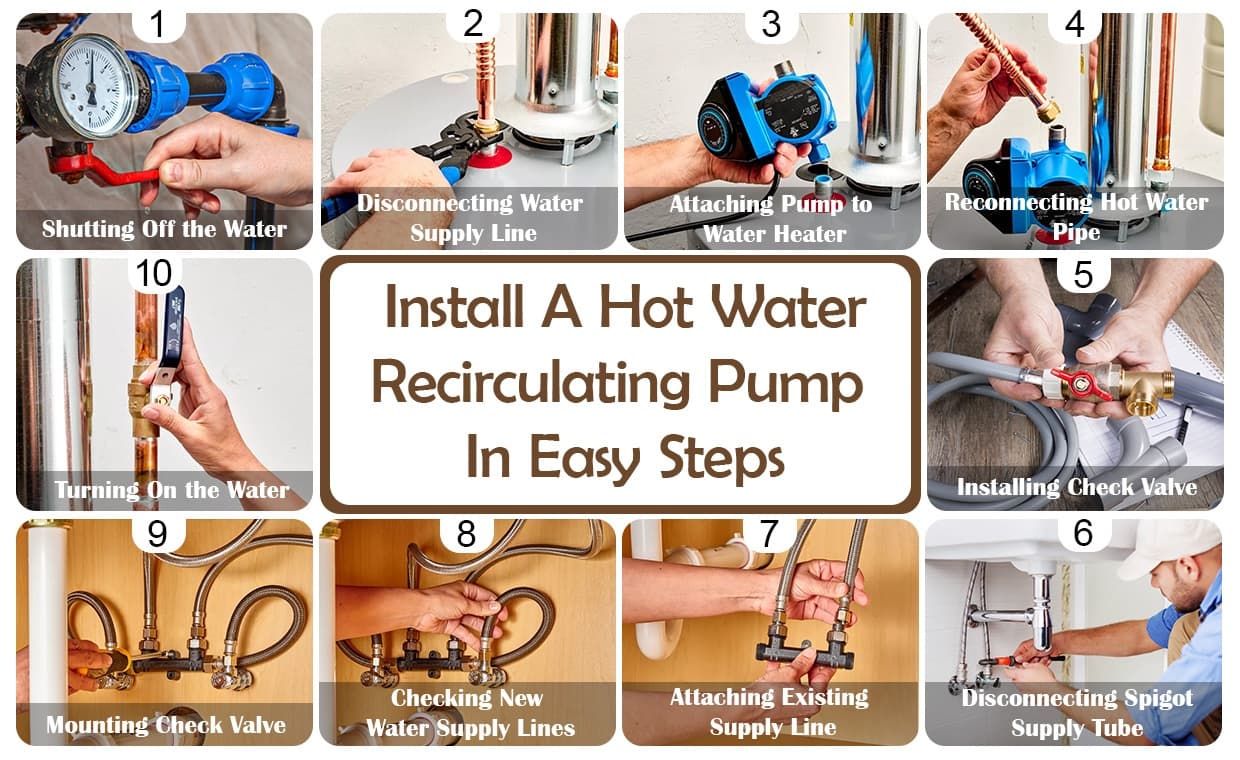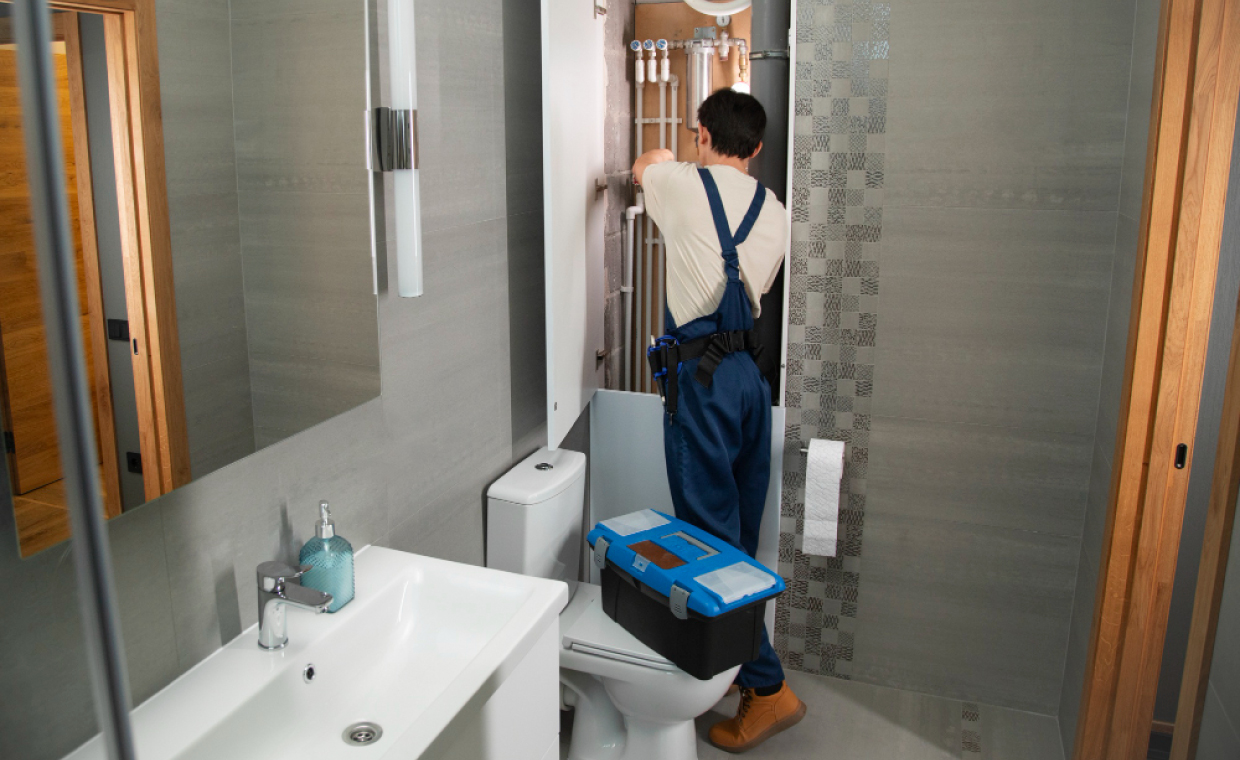
Do you want to reduce water bills, save water, and eliminate cold showers at home? If yes, and you have not yet found a water solution, worry no more. We have a solution for you. We will tell you how to install a hot water recirculating pump yourself. All you need to do is install a hot water circulation pump on your water heater and let it do its job.
With a recirculating hot water pump in your home, you get an efficient and reliable instant hot water supply to faucets and showers. This helps cut down on the waste of water that would otherwise run down the drain while waiting for hot water to pour from the tap.
What is a Hot Water Recirculation Pump?

A hot water recirculation pump circulates instant hot water from showers or faucets upon demand. This device returns unused hot water to the water heater.
Let us try to understand the entire process of a hot water pump recirculating system. When you use hot water, it continuously flows through the pipe. After using hot water, when we turn off the faucet, the hot water left in the pipe does not return to the water heater. Rather, the remaining hot water stays in the pipe and gets cold. Next time, when we turn on the faucet for hot water, the cold water stored in the pipe must be pushed out by the hot water. Therefore, we get cold water for some time. The duration of cold water coming out of the pipe depends on the length of the pipe between the water heater and the faucet. The hot water recirculating pump helps recirculate that left-over hot water so that we get instant hot water the next time we turn the faucet on.
What are the Advantages of a Hot Water Recirculation Pump?
Below are a few advantages of a hot water heater recirculating pump.
- No More Waiting: If you’ve had a water heater, you know how long it takes for the hot water to pour from the tap. If you install a hot water recirculating pump, you cut off this waiting completely.
- No Wastage of Water: In the case of water heaters, we tend to pour out litres of cold water while waiting for the hot water to pour. A hot water recirculation pump will stop wastage of cold water.
- Prevents Freezing of Pipes: When a hot water recirculation system is in place, it will ensure that hot water is always available in your taps. This prevents pipes from freezing during the winter.
- Decent Energy Consumption: Hot water recirculation pumps use a decent amount of energy, which again is a potential cost-saving factor.
What are the Disadvantages of a Hot Water Recirculation Pump?
Below are a few disadvantages of a hot water heater recirculating pump.
- Initial Cost: You may have to invest some amount while installing the pump, which would include the cost of the machine and the installation cost. However, if you opt to do this as a DIY project, then you can save on the installation cost.
- Work with Lukewarm Water: If there is no return line for hot water, then getting cold water will be a bit of a struggle for you. You may have to work with lukewarm water until you get cold water.
- Sensor Valve Replacement: Many users complain that they must change the sensor valve frequently. It becomes a challenge when the valve is inside the water pump. It is easier to replace the valve when it is outside the pump.
How Much Does It Cost to Install a Hot Water Recirculation Pump?
The cost of installing a hot water recirculation pump on your water heater ranges from $500 to $1000 if you hire a plumber. However, as mentioned earlier, it can cost you zero dollars if you do it yourself. A hot water recirculation pump is a good investment for a large family. The pump will pay for itself in three to four years for a family of four. Apart from the money calculations, it is also worthwhile, especially when one considers the pump’s water-saving potential.
How Does a Hot Water Recirculation System Work?

A hot water recirculation pump works through a check valve installed at the sink and a circulation pump installed on the water heater. The check valve is sensitive to heat and circulates water to the water heater until it’s hot enough.
When the water in the hot water pipe is ready for use, the check valves shut off. This makes the water in hot water pipes always ready to use, preventing you from wasting gallons of cold water. Cold water returns to the system through the cold water line when not in use.
How To Install A Hot Water Recirculating Pump: Step-By-Step Process
Hot water recirculation pump installation is easy. However, if you are not a DIY plumbing type, this project is not for you; the water can be extremely hot as you complete the work, causing various scenarios.
Tools and Materials Needed

Below are the tools and materials required to install hot water recirculating pump.
- Bucket and towel
- Recirculation pump kit (including check valve and flex supply)
- Screwdriver
Steps To Install Hot Water Heater Recirculating Pump
Step 1: Shut off the Water

- On the cold pipe extending into the water heater, shut the water off at the shut-off valve on top of the water heater.
- Open a hot water faucet in the house to check if the hot water flow has stopped completely. If the shut-off valve didn’t completely stop the water, shut the main water supply off.
- Shut the water heater off and wait for a few minutes for the water to cool before continuing.
Step 2: Disconnect the Water Supply Line

- On the water heater side, disconnect the water supply line where it extends to the water heater.
- Using a rag, catch any residue water that comes out after disconnecting the pipe.
Step 3: Screw the Pump onto the Water Heater

- Onto the water heater’s hot side, screw the pump as you ensure that the timer face is in the direction where you can adjust it with ease.
Step 4: Reconnect the Hot Water Pipe

- Now, reattach the hot water line to the recirculation pump’s top and use channel-type pliers to tighten it.
- If necessary, loop the flexible line, ensuring no kinks restrict water flow.
Step 5: Install the Check Valve

- Shut the water leading to the faucets off by closing the supply valves controlling the cold and hot water supply tubes.
- Then, on your farthest sink from the water heater, install the check valve.
Step 6: Disconnect the Spigot Supply Tube

- Disconnect the faucet supply tubes from the shut-off valves underneath the sink.
- Use a container and a towel to catch the water that may drain out after disconnecting the tubes.
- Next, connect the check valve with the faucet supply lines
Step 7: Screw the Existing Supply Line

- For the existing supply lines that come down from the tailpieces of the faucet, screw them on the two top outlets onto the check valve.
- Ensure that the cold water pipe is positioned on the right and the hot water line is on the left.
Step 8: Check the New Water Supply Lines

- Confirm whether the upgraded water supply lines are connected to the right valve by running them from the cold and hot water shut-off valve to the check valve.
- The cold water pipe should be on the right, and the hot water pipe on the left, as they come up via the floor or out of the wall.
Step 9: Mount the Check Valve

- Check if the supply lines are tightly connected, and then use the screws included with the kit to mount the check valve onto the wall.
Step 10: Turn the Water On

- Turn on the water back to the water heater and the sink faucet.
- Run water at the farthest sink until the air inside the line is out.
- Check all the connections to ensure there are no leakages before plugging the power supply into the recirculation pump.
Step 11: Set the Pump Up
- Set the recirculating hot water pump up by programing the times you’d wish the pump to run. The timer enables you to set the operation so that the pump runs whenever hot water is required.
- After successfully setting up the pum, you can enjoy endless hot water in your shower and faucets.
Can you see how installing a hot water recirculation pump system on your water heater can end the long wait for hot water, saving your time, water and money? The ball is now in your court. Good luck buddy!
Image Courtesy: Image 1, Image 2, Image 3, Image 4, Image 6, Image 7, Image 8, Image 11, Image 12, Image 13, Image 14
Author Bio
Fidelis Kinai – Fidelis Muti possess a bachelor’s in English and Journalism and have over four years of professional experienced writing and proofreading materials for print and online platforms, including newspapers, magazines, websites, blogs, and social media accounts. He also have over three years of experience as a marketing assistant and social media manager.
He is versatile and diligent and will produce exemplary content within time to meet your deadline.
He can deliver most work within 2-3 days; rush orders are accepted whenever possible. He is based in the Kenya but travel often and work for clients all over the world.






























